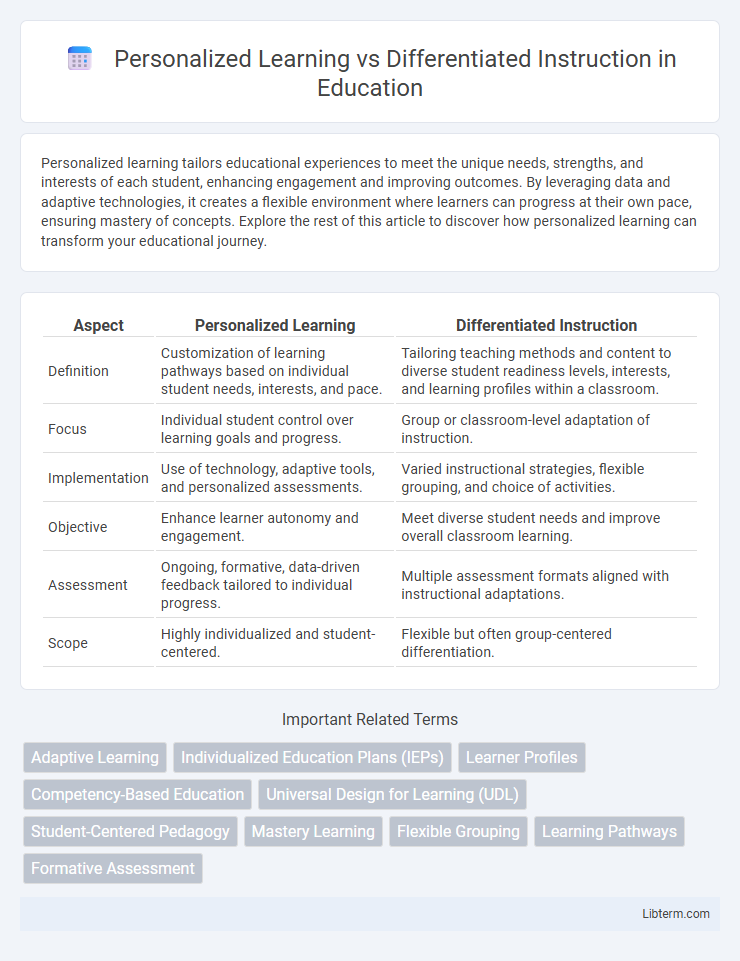Personalized learning tailors educational experiences to meet the unique needs, strengths, and interests of each student, enhancing engagement and improving outcomes. By leveraging data and adaptive technologies, it creates a flexible environment where learners can progress at their own pace, ensuring mastery of concepts. Explore the rest of this article to discover how personalized learning can transform your educational journey.
Table of Comparison
| Aspect | Personalized Learning | Differentiated Instruction |
|---|---|---|
| Definition | Customization of learning pathways based on individual student needs, interests, and pace. | Tailoring teaching methods and content to diverse student readiness levels, interests, and learning profiles within a classroom. |
| Focus | Individual student control over learning goals and progress. | Group or classroom-level adaptation of instruction. |
| Implementation | Use of technology, adaptive tools, and personalized assessments. | Varied instructional strategies, flexible grouping, and choice of activities. |
| Objective | Enhance learner autonomy and engagement. | Meet diverse student needs and improve overall classroom learning. |
| Assessment | Ongoing, formative, data-driven feedback tailored to individual progress. | Multiple assessment formats aligned with instructional adaptations. |
| Scope | Highly individualized and student-centered. | Flexible but often group-centered differentiation. |
Defining Personalized Learning
Personalized learning tailors educational experiences to individual students' strengths, needs, interests, and pace, emphasizing student agency and choice. It employs adaptive technologies and data-driven insights to create customized learning pathways that foster engagement and mastery. This approach contrasts with differentiated instruction, which modifies teaching methods and materials within a uniform curriculum to accommodate diverse learners.
Understanding Differentiated Instruction
Differentiated instruction tailors teaching methods, content, and assessments to accommodate diverse learner needs within the same classroom environment. It employs strategies like flexible grouping, varied assignments, and ongoing assessment to address students' readiness levels, interests, and learning profiles. This approach ensures equitable access to the curriculum by adjusting instructional practices without altering the core learning objectives.
Core Principles: Personalized Learning vs Differentiated Instruction
Personalized learning centers on tailoring educational experiences to individual student interests, readiness, and learning profiles, promoting autonomy and self-paced progress. Differentiated instruction adapts teaching methods, content, and assessments within a diverse classroom to meet varied learner needs while following a common curriculum framework. Both approaches prioritize student engagement and growth but differ in scope, with personalized learning offering a more customized path and differentiated instruction focusing on responsive teaching strategies.
Key Differences in Approach
Personalized learning tailors educational experiences to individual student interests, pace, and learning styles using technology-driven tools and adaptive content, promoting learner autonomy. Differentiated instruction addresses diverse student needs within a classroom by varying teaching methods, materials, and assessments to accommodate readiness levels and learning preferences. The key difference lies in personalized learning's focus on individual learner control versus differentiated instruction's emphasis on responsive teaching strategies applied collectively.
Roles of Teachers and Students
Personalized learning centers on tailoring educational experiences to individual student interests, strengths, and pace, requiring teachers to act as facilitators and mentors who design customized learning pathways. In differentiated instruction, educators adjust content, process, and products based on students' readiness, learning styles, and interests within a single classroom, emphasizing the teacher's role in managing diverse needs simultaneously. Students in personalized learning take active responsibility for their progress, exercising autonomy and self-regulation, while in differentiated instruction, they engage with varied tasks and materials selected by the teacher to suit group-based or individual differences.
Technology’s Influence on Both Methods
Technology enhances personalized learning by leveraging adaptive algorithms and data analytics to tailor educational content to individual student needs, pacing, and interests. In differentiated instruction, technology facilitates diverse teaching strategies through multimedia resources, interactive platforms, and real-time assessment tools that address varied learning styles and abilities within the same classroom. Both methods benefit from digital tools like learning management systems and AI-driven applications that provide actionable insights, enabling educators to optimize student engagement and outcomes effectively.
Benefits of Personalized Learning
Personalized learning enhances student engagement by tailoring educational experiences to individual interests, learning styles, and pace, leading to improved academic outcomes. It fosters self-regulation and motivation, empowering learners to take ownership of their education through adaptive technologies and customized feedback. This approach supports diverse learners by addressing specific strengths and challenges, promoting equity and maximizing potential in heterogeneous classrooms.
Advantages of Differentiated Instruction
Differentiated instruction enhances student engagement by tailoring teaching methods to varied learning styles and readiness levels within a classroom. This approach supports diverse academic needs, promoting equitable access to the curriculum and improving overall student achievement. Teachers can use ongoing assessments to adjust lessons, fostering a dynamic and responsive learning environment.
Challenges and Limitations
Personalized learning faces challenges such as the need for advanced technology and extensive teacher training to effectively tailor content to individual student needs, which can limit scalability in diverse classrooms. Differentiated instruction struggles with balancing varied student readiness levels, interests, and learning profiles while maintaining curriculum standards and assessment consistency. Both approaches may encounter limitations related to resource allocation, time constraints, and educator expertise, impacting their successful implementation.
Choosing the Right Approach for Your Classroom
Personalized learning tailors educational experiences to individual student interests, pace, and learning styles, leveraging technology to adapt content dynamically. Differentiated instruction modifies teaching methods and materials within the same classroom setting to address varying student readiness levels and preferences. Selecting the right approach depends on classroom size, resources, student diversity, and learning goals, with personalized learning offering deeper customization and differentiated instruction supporting varied needs through flexible strategies.
Personalized Learning Infographic

 libterm.com
libterm.com